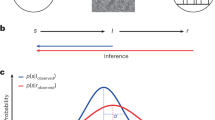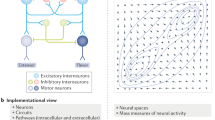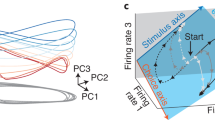Abstract
The Bayesian brain hypothesis is one of the most influential ideas in neuroscience. However, unstated differences in how Bayesian ideas are operationalized make it difficult to draw general conclusions about how Bayesian computations map onto neural circuits. Here, we identify one such unstated difference: some theories ask how neural circuits could recover information about the world from sensory neural activity (Bayesian decoding), whereas others ask how neural circuits could implement inference in an internal model (Bayesian encoding). These two approaches require profoundly different assumptions and lead to different interpretations of empirical data. We contrast them in terms of motivations, empirical support and relationship to neural data. We also use a simple model to argue that encoding and decoding models are complementary rather than competing. Appreciating the distinction between Bayesian encoding and Bayesian decoding will help to organize future work and enable stronger empirical tests about the nature of inference in the brain.
This is a preview of subscription content, access via your institution
Access options
Access Nature and 54 other Nature Portfolio journals
Get Nature+, our best-value online-access subscription
$29.99 / 30 days
cancel any time
Subscribe to this journal
Receive 12 print issues and online access
$209.00 per year
only $17.42 per issue
Buy this article
- Purchase on Springer Link
- Instant access to full article PDF
Prices may be subject to local taxes which are calculated during checkout




Similar content being viewed by others
Code availability
Two panels in Fig. 4 were generated by simulation. The code is available at https://github.com/haefnerlab/bayesian-encoding-decoding/.
References
von Helmholtz, H. Treatise on Physiological Optics (The Optical Society of America, 1925).
Knill, D. C. & Richards, W. Perception as Bayesian Inference (Cambridge Univ. Press, 1996).
Kersten, D., Mamassian, P. & Yuille, A. Object perception as Bayesian inference. Annu. Rev. Psychol. 55, 271–304 (2004).
Fiser, J., Berkes, P., Orbán, G. & Lengyel, M. Statistically optimal perception and learning: from behavior to neural representations. Trends Cogn. Sci. 14, 119–130 (2010).
Pouget, A., Beck, J. M., Ma, W. J. & Latham, P. E. Probabilistic brains: knowns and unknowns. Nat. Neurosci. 16, 1170–1178 (2013).
Shivkumar, S., Lange, R. D., Chattoraj, A. & Haefner, R. M. A probabilistic population code based on neural samples. Adv. Neural Inf. Process. Syst. 31, 7070–7079 (2018).
Olshausen, B. A. & Field, D. J. Emergence of simple-cell receptive field properties by learning a sparse code for natural images. Nature 381, 607–609 (1996).
Olshausen, B. A. & Field, D. J. Sparse coding with an incomplete basis set: a strategy employed by V1? Vis. Res. 37, 3311–3325 (1997).
Zemel, R. S., Dayan, P. & Pouget, A. Probabilistic interpretation of population codes. Neural Comput. 10, 403–430 (1998).
Berkes, P., Orbán, G., Lengyel, M. & Fiser, J. Spontaneous cortical activity reveals hallmarks of an optimal internal model of the environment. Science 331, 83–87 (2011).
Dayan, P., Hinton, G. E., Neal, R. & Zemel, R. The Helmholtz machine. Neural Comput. 7, 889–904 (1995).
Dayan, P. & Abbott, L. F. Theoretical Neuroscience: Computational and Mathematical Modeling of Neural Systems (MIT Press, 2001).
Bell, A. J. & Sejnowski, T. J. The ‘independent components’ of scenes are edge filters. Vis. Res. 37, 3327–3338 (1997).
Murphy, K. P. Machine Learning: a Probabilistic Perspective (MIT Press, 2012).
Wainwright, M. J. & Jordan, M. I. Graphical models, exponential families, and variational inference. Found. Trends Mach. Learn. 1, 1–305 (2008).
Bishop, C. M. Pattern Recognition and Machine Learning (Springer, 2006).
Sanborn, A. N. Types of approximation for probabilistic cognition: sampling and variational. Brain Cogn. 112, 98–101 (2015).
Gershman, S. J. & Beck, J. M. in Computational models of brain and behavior (ed. A. Moustafa), 453–466 (Wiley-Blackwell, 2016).
Ma, W. J., Beck, J. M., Latham, P. E. & Pouget, A. Bayesian inference with probabilistic population codes. Nat. Neurosci. 9, 1432–1438 (2006).
Beck, J. M. et al. Probabilistic population codes for Bayesian decision-making. Neuron 36, 1142–1152 (2008).
Fetsch, C. R., Pouget, A., DeAngelis, G. C. & Angelaki, D. E. Neural correlates of reliability-based cue weighting during multisensory integration. Nat. Neurosci. 15, 146–154 (2011).
Fetsch, C. R., DeAngelis, G. C. & Angelaki, D. E. Bridging the gap between theories of sensory cue integration and the physiology of multisensory neurons. Nat. Rev. Neurosci. 14, 429–442 (2013).
Hou, H., Zheng, Q., Zhao, Y., Pouget, A. & Gu, Y. Neural correlates of optimal multisensory decision making under time-varying reliabilities with an invariant linear probabilistic population code. Neuron 104, 1010–1021 (2019).
Orbán, G., Berkes, P., Fiser, J. & Lengyel, M. Neural variability and sampling-based probabilistic representations in the visual cortex. Neuron 92, 530–543 (2016).
Haefner, R. M., Berkes, P. & Fiser, J. Perceptual decision-making as probabilistic inference by neural sampling. Neuron 90, 649–660 (2016).
Bányai, M. et al. Stimulus complexity shapes response correlations in primary visual cortex. Proc. Natl Acad. Sci. USA 116, 2723–2732 (2019).
Lange, R. D. & Haefner, R. M. Task-induced neural covariability as a signature of approximate Bayesian learning and inference. PLoS Comput. Biol. 18, e1009557 (2022).
Campbell, D. T. in Studies in the Philosophy of Biology (ed. F. J. Ayala) 179–186 (Macmillan, 1974).
Yablo, S. Mental causation. Philos. Rev. 101, 245–280 (1992).
Morris, R. Developments of a water-maze procedure for studying spatial learning in the rat. J. Neurosci. Methods 11, 47–60 (1984).
Beck, J. M., Heller, K. & Pouget, A. Complex inference in neural circuits with probabilistic population codes and topic models. Adv. Neural Inf. Process. Syst. 25, 3068–3076 (2012).
Ernst, M. O. & Banks, M. S. Humans integrate visual and haptic information in a statistically optimal fashion. Nature 415, 429–433 (2002).
Knill, D. C. & Pouget, A. The Bayesian brain: the role of uncertainty in neural coding and computation. Trends Neurosci. 27, 712–719 (2004).
Alais, D. & Burr, D. The ventriloquist effect results from near-optimal bimodal integration. Curr. Biol. 14, 257–262 (2004).
Körding, K. P. Decision theory: what ‘should’ the nervous system do? Science 318, 606–610 (2007).
Angelaki, D. E., Gu, Y. & DeAngelis, G. C. Multisensory integration: psychophysics, neurophysiology, and computation. Curr. Opin. Neurobiol. 19, 452–458 (2009).
Walker, E. Y., Cotton, R. J., Ma, W. J. & Tolias, A. S. A neural basis of probabilistic computation in visual cortex. Nat. Neurosci. 23, 122–129 (2019).
Rahnev, D. The Bayesian brain: what is it and do humans have it? Behav. Brain Sci. 42, e238 (2019).
Koblinger, Á., Fiser, J. & Lengyel, M. Representations of uncertainty: where art thou? Curr. Opin. Behav. Sci. 38, 150–162 (2021).
Jaynes, E. T. Probability Theory: the Logic of Science (Cambridge Univ. Press, 2003).
Aitchison, L. & Lengyel, M. The hamiltonian brain: efficient probabilistic inference with excitatory–inhibitory neural circuit dynamics. PLoS Comput. Biol. 12, e1005186 (2016).
Echeveste, R., Aitchison, L., Hennequin, G. & Lengyel, M. Cortical-like dynamics in recurrent circuits optimized for sampling-based probabilistic inference. Nat. Neurosci. 23, 1138–1149 (2020).
George, D. & Hawkins, J. Towards a mathematical theory of cortical micro-circuits. PLoS Comput. Biol. 5, e1000532 (2009).
Raju, R. V. & Pitkow, X. in Advances in Neural Information Processing Systems vol. 30 (eds. Lee, D. D. et al.) 2029–2037 (Curran Associates, 2016).
Grabska-Barwinska, A., Beck, J. M., Pouget, A. & Latham, P. E. in Advances in Neural Information Processing Systems vol. 26 (eds. Burges, C. J. C. et al.) 1968–1976 (Curran Associates, 2013).
George, D. et al. Cortical microcircuits from a generative vision model. Preprint at https://arxiv.org/abs/1808.01058 (2018).
Friston, K. J. A theory of cortical responses. Philos. Trans. R. Soc. Lond. B Biol. Sci. 360, 815–836 (2005).
Lavin, A., Guntupalli, J. S., Lázaro-gredilla, M., Lehrach, W. & George, D. Explaining visual cortex phenomena using recursive cortical network. Preprint at bioRxiv https://doi.org/10.1101/380048 (2018).
Vertes, E. & Sahani, M. in Advances in Neural Information Processing Systems vol. 31 (eds Bengio, S. et al.) (Curran Associates, 2018).
Moreno-Bote, R., Knill, D. C. & Pouget, A. Bayesian sampling in visual perception. Proc. Natl Acad. Sci. USA 108, 12491–12496 (2011).
Gershman, S. J., Vul, E. & Tenenbaum, J. B. Multistability and perceptual inference. Neural Comput. 24, 1–24 (2012).
Hohwy, J., Roepstorff, A. & Friston, K. J. Predictive coding explains binocular rivalry: an epistemological review. Cognition 108, 687–701 (2008).
Hoyer, P. O. & Hyvärinen, A. Interpreting neural response variability as monte carlo sampling of the posterior. Adv. Neural Inf. Process. Syst. 17, 293–300 (2003).
Schwartz, O. & Simoncelli, E. P. Natural signal statistics and sensory gain control. Nat. Neurosci. 4, 819–825 (2001).
Bornschein, J., Henniges, M. & Lücke, J. Are V1 simple cells optimized for visual occlusions? a comparative study. PLoS Comput. Biol. 9, e1003062 (2013).
Coen-Cagli, R., Kohn, A. & Schwartz, O. Flexible gating of contextual influences in natural vision. Nat. Neurosci. 18, 1648–1655 (2015).
Graf, A. B. A., Kohn, A., Jazayeri, M. & Movshon, J. A. Decoding the activity of neuronal populations in macaque primary visual cortex. Nat. Neurosci. 14, 239–247 (2011).
Orhan, A. E. & Ma, W. J. Efficient probabilistic inference in generic neural networks trained with non-probabilistic feedback. Nat. Commun. 8, 138 (2017).
Block, N. If perception is probabilistic, why does it not seem probabilistic? Philos. Trans. R. Soc. Lond. B Biol. Sci. 373, 20170341 (2018).
Rahnev, D., Block, N., Jehee, J. & Denison, R. Is perception probabilistic? Clarifying the definitions. Preprint at https://psyarxiv.com/f8v5r/ (2020).
Sahani, M. & Dayan, P. Doubly distributional population codes: simultaneous representation of uncertainty and multiplicity. Neural Comput. 15, 2255–2279 (2003).
Vul, E. & Rich, A. N. Independent sampling of features enables conscious perception of bound objects. Psychol. Sci. 21, 1168–1175 (2010).
Sanborn, A. N., Griffiths, T. L. & Navarro, D. J. Rational approximations to rational models: alternative algorithms for category learning. Psychol. Rev. 117, 1144–1167 (2010).
Lieder, F., Hsu, M. & Griffiths, T. L. The high availability of extreme events serves resource-rational decision-making. In Proc. 36th Annual Conference of the Cognitive Science Society (eds. Bello, P. et al.) 2567–2572 (Cognitive Science Soc., 2014).
Vul, E., Goodman, N. D., Griffiths, T. L. & Tenenbaum, J. B. One and done? Optimal decisions from very few samples. Cogn. Sci. 38, 599–637 (2014).
Sanborn, A. N. & Chater, N. Bayesian brains without probabilities. Trends Cogn. Sci. 20, 883–893 (2016).
Lieder, F., Griffiths, T. L., Huys, Q. J. M. & Goodman, N. D. The anchoring bias reflects rational use of cognitive resources. Psychon. Bull. Rev. 25, 322–334 (2017).
Zhu, J.-Q., Sanborn, A. N. & Chater, N. The Bayesian sampler: generic Bayesian inference causes incoherence in human probability judgments. Psychol. Rev. 127, 719–748 (2020).
Daw, N. D., Courville, A. C. & Dayan, P. in the Probabilistic Mind: Prospects for Bayesian Cognitive Science (eds. Chater, N. & Oaksford, M.) https://doi.org/10.1093/acprof:oso/9780199216093.003.0019 (Oxford Scholarship Online, 2008).
Sanborn, A. N. & Silva, R. Constraining bridges between levels of analysis: a computational justification for locally Bayesian learning. J. Math. Psychol. 57, 94–106 (2013).
Lange, R. D., Chattoraj, A., Beck, J. M., Yates, J. L. & Haefner, R. M. A confirmation bias in perceptual decision-making due to hierarchical approximate inference. PLoS Comput. Biol. 17, e1009517 (2021).
Griffiths, T. L., Vul, E. & Sanborn, A. N. Bridging levels of analysis for probabilistic models of cognition. Curr. Dir. Psychol. Sci. 21, 263–268 (2012).
Jaakkola, T. S. & Jordan, M. I. in Learning in Graphical Models (ed. Jordan, M. I.) 163–174 (Kluwer, 1998).
Lange, R. D., Benjamin, A. S., Haefner, R. M. & Pitkow, X. Interpolating between sampling and variational inference with infinite stochastic mixtures. Proc. Machine Learn. Res. 180, 1063–1073 (2022).
Walker, E. Y. et al. Studying the neural representations of uncertainty. Nat. Neurosci. 26, 1857–1867 (2023).
Pecevski, D., Buesing, L. & Maass, W. Probabilistic inferences general graphical models through sampling in stochastic networks of spiking neurons. PLoS Comput. Biol. 7, e1002294 (2011).
Buesing, L., Bill, J., Nessler, B. & Maass, W. Neural dynamics as sampling: a model for stochastic computation in recurrent networks of spiking neurons. PLoS Comput. Biol. 7, e1002211 (2011).
Savin, C. & Denève, S. Spatio-temporal representations of uncertainty in spiking neural networks. In Advances in Neural Information Processing Systems vol. 27 2024–2032 (NIPS, 2014).
Probst, D. et al. Probabilistic inference in discrete spaces can be implemented into networks of LIF neurons. Front. Comput. Neurosci. 9, 13 (2015).
Festa, D., Aschner, A., Davila, A., Kohn, A. & Coen-Cagli, R. Neuronal variability reflects probabilistic inference tuned to natural image statistics. Nat. Commun. 12, 3635 (2021).
Tajima, C. I. et al. Population code dynamics in categorical perception. Sci. Rep. 6, 22536 (2016).
Beck, J. M., Latham, P. E. & Pouget, A. Marginalization in neural circuits with divisive normalization. J. Neurosci. 31, 15310–15319 (2011).
Acknowledgements
We thank the many colleagues with whom we have discussed the ideas in this paper, especially M. Lengyel and J. Drugowitsch for their detailed comments on an earlier version of this manuscript. This work was supported by the National Institutes of Health (NIH) R01 grant EY028811, NIH U19 grant 1U19NS118246-01 and a National Science Foundation CAREER grant IIS-2143440 to R.M.H.
Author information
Authors and Affiliations
Corresponding author
Ethics declarations
Competing interests
The authors declare no competing interests.
Peer review
Peer review information
Nature Neuroscience thanks Máté Lengyel, Cristina Savin, and the other, anonymous, reviewer(s) for their contribution to the peer review of this work.
Additional information
Publisher’s note Springer Nature remains neutral with regard to jurisdictional claims in published maps and institutional affiliations.
Supplementary information
Supplementary Information
Supplementary Note containing derivation of equation (5).
Rights and permissions
Springer Nature or its licensor (e.g. a society or other partner) holds exclusive rights to this article under a publishing agreement with the author(s) or other rightsholder(s); author self-archiving of the accepted manuscript version of this article is solely governed by the terms of such publishing agreement and applicable law.
About this article
Cite this article
Lange, R.D., Shivkumar, S., Chattoraj, A. et al. Bayesian encoding and decoding as distinct perspectives on neural coding. Nat Neurosci 26, 2063–2072 (2023). https://doi.org/10.1038/s41593-023-01458-6
Received:
Accepted:
Published:
Issue Date:
DOI: https://doi.org/10.1038/s41593-023-01458-6



